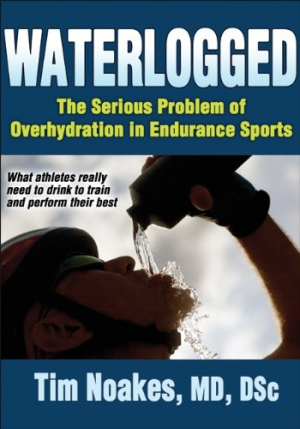
Waterlogged
The Serious Problem of Hydration in Endurance Sports
The days of athletes drinking during exercise and chugging liquids before endurance races may well be over. And while this may still be news to some, Tim Noakes has recognized the danger of these practices for decades.
A physician, professor, ex-marathon runner, and cofounder of the Sports Science Institute of South Africa, Noakes’s book, Waterlogged: The Serious Problem of Overhydration in Endurance Sports, presents new evidence intended to alter the way endurance athletes and recreational enthusiasts approach hydration. According to him, “tens of millions of athletes and fitness enthusiasts are waterlogged in that the hydration practices to which they religiously adhere adversely affect their health and performance.” It’s simple: endurance athletes can do more by drinking less.
Waterlogged seeks to revise over thirty years of research and studies conducted by physicians and scientists whom, Noakes explains, “drew conclusions from their data according to what they believed was true.” These “experts,” many of whom work for energy drink and sports-apparel companies like Gatorade and Nike, were motivated by the commercial success of their products, not the safety and welfare of marathon runners and other endurance athletes.
After the popularity of marathons began to grow exponentially in 1976, runners were told to drink more and train less, leading to potentially fatal consequences. Noakes presents the tragic case of Cynthia Lucero, who died as a result of abnormal fluid retention while running the 2002 Boston Marathon. Lucero’s “rate of fluid intake was precisely the rate recommended by Gatorade advertisements published in New York Runner and Runner’s World three months earlier.”
While questioning and discrediting the post-1976 research findings of many scientists, Noakes presents his own research through tables, charts, and graphs. He begins by taking a look at human physiology and its evolutionary history and explains what happens in the body when too much fluid is ingested. The reader is introduced to terms such as “exercise-associated hyponatremic encephalopathy” and “inappropriate antidiuretic hormone secretion.” At times, sorting through the book’s science can be exhausting, but Noakes supplements his research with enlightening narratives.
Noakes not only questions contemporary scientific conclusions, he presents new conclusions based on the traditional knowledge of human physiology and evolution. “If humans truly are made to run for prolonged periods in extreme dry heat while drinking little or nothing,” he writes, “we must question the advice to drink at high rates and to ingest sodium during exercise regardless of the duration of the exercise or the environmental conditions.”
If they take nothing else away, Noakes wants readers to examine the science behind the facts as well as the evidence before accepting them as the universal truths. The book is especially useful to endurance athletes hoping to explore the topic of drinking during exercise, and might just alter the course of future research in the field.
Reviewed by
Andrew Kipp
Disclosure: This article is not an endorsement, but a review. The publisher of this book provided free copies of the book and paid a small fee to have their book reviewed by a professional reviewer. Foreword Reviews and Clarion Reviews make no guarantee that the publisher will receive a positive review. Foreword Magazine, Inc. is disclosing this in accordance with the Federal Trade Commission’s 16 CFR, Part 255.
